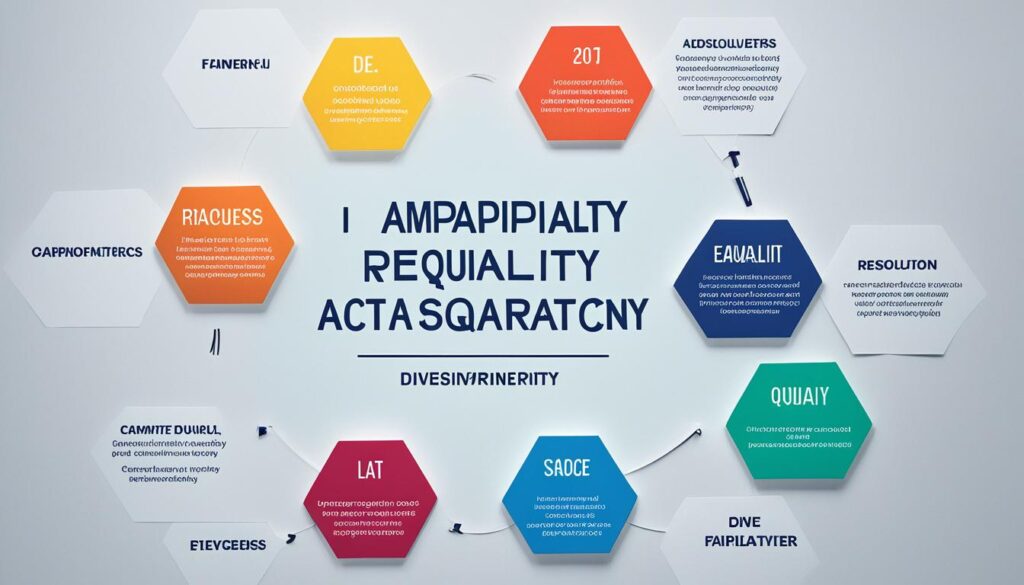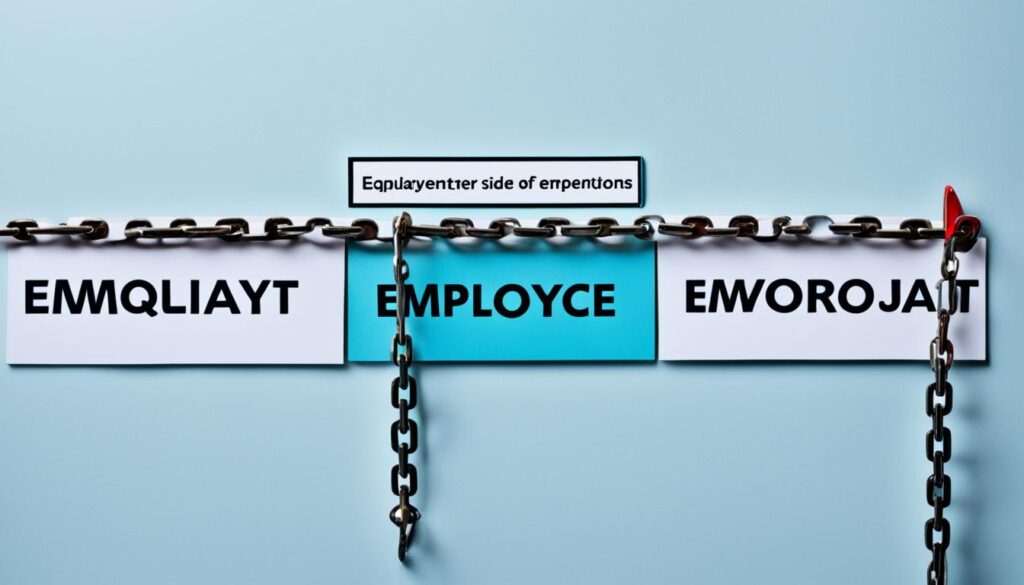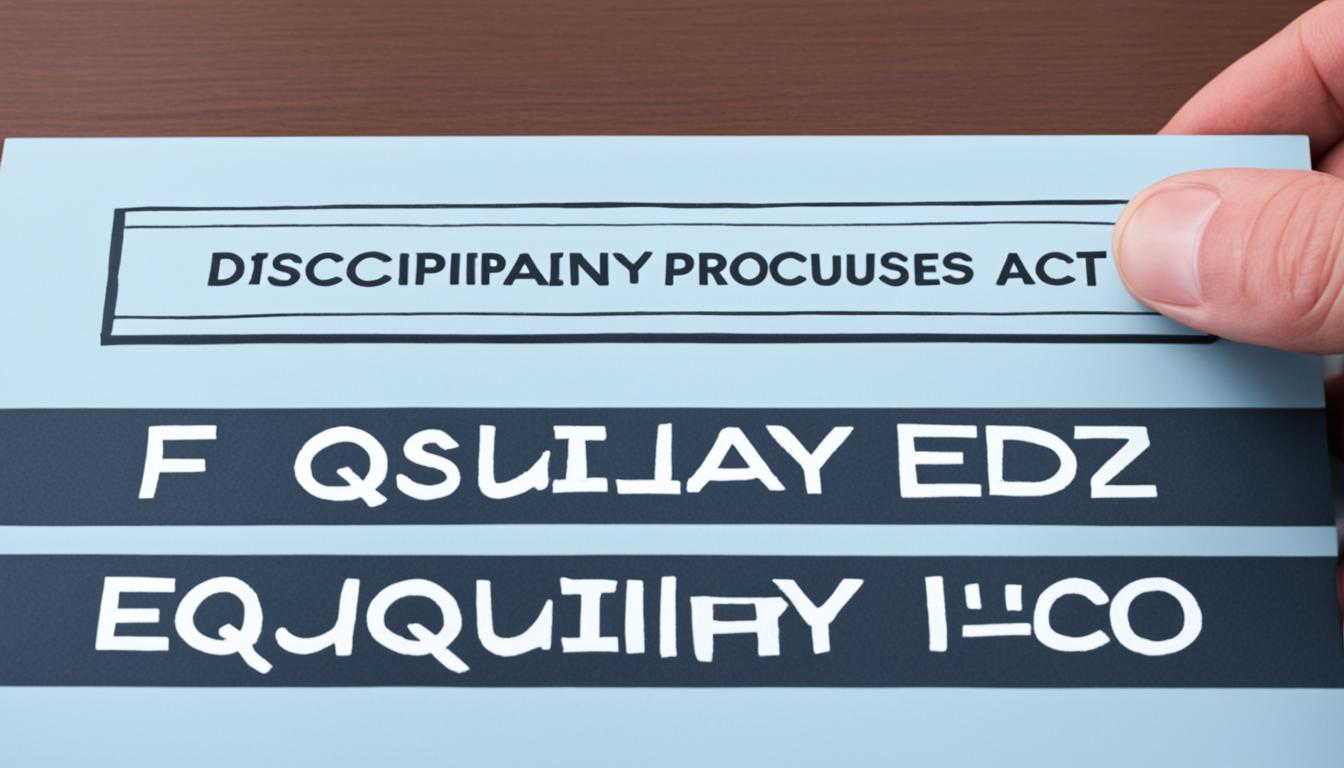The Impact of the Equality Act 2010 on Disciplinary Procedures
Welcome to our article on the Equality Act 2010 and its impact on disciplinary procedures in the workplace. Did you know that the Equality Act 2010 protects employees from unfair treatment based on their disability? This means that employers have a legal obligation to ensure that disciplinary actions are handled in a fair and non-discriminatory manner. Let’s explore how the Equality Act 2010 affects disciplinary procedures and what employers need to consider to comply with the law.
Key Takeaways:
- The Equality Act 2010 prohibits employers from treating employees unfavorably due to their disability.
- Disciplinary actions must consider various factors, including the nature of the behavior, impact on others, and reasonable adjustments made.
- Open and factual conversations between employers and employees are crucial for understanding and resolving disciplinary issues.
- Managing performance in accordance with the Equality Act 2010 requires fair discussions and reasonable adjustments.
- An employer may consider dismissal, but only after exploring all possible support and alternative roles.
Understanding Section 15 of the Equality Act 2010
Section 15 of the Equality Act 2010 plays a crucial role in shaping the discipline regulations established under the Act. This section prohibits employers from treating employees unfavorably “because of something arising in consequence of” their disability, unless there is a valid justification for such treatment. It ensures that employees with disabilities are protected from discriminatory practices when it comes to disciplinary actions.
Under Section 15 of the Equality Act 2010, employers are required to take into account the impact of an employee’s disability on their behavior or conduct. It is essential to consider these factors when determining disciplinary measures, ensuring that employees are not treated unfairly due to their disability. By adhering to the regulations outlined in the Act, employers can create a supportive and inclusive environment for all employees.
To gain a better understanding of the implications of Section 15 of the Equality Act 2010, let’s examine a hypothetical scenario:
In a workplace, an employee with a disability engages in behavior that is considered disruptive or inappropriate. In line with the discipline regulations under the Equality Act 2010, the employer acknowledges that the behavior arises as a consequence of the employee’s disability. The employer then engages in a thorough process of investigation, taking into account all relevant factors and considering reasonable adjustments that can be made to support the employee’s conduct. By following the requirements of Section 15 of the Equality Act 2010, the employer demonstrates a commitment to fairness and inclusivity in their disciplinary actions.
Understanding and implementing the discipline regulations outlined in the Equality Act 2010, specifically Section 15, are essential for employers to ensure that employees with disabilities are treated fairly and not subjected to discrimination. By promoting a culture of understanding, support, and reasonable adjustments, employers can effectively manage disciplinary situations while upholding the principles of equality and inclusivity.
Continue reading to explore the considerations for disciplinary actions under the Equality Act 2010 in Section 3.
| Benefits of Understanding Section 15 of the Equality Act 2010 | Implications of Ignoring Section 15 of the Equality Act 2010 |
|---|---|
|
|
Considerations for Disciplinary Actions
When managing disciplinary actions in accordance with the Equality Act 2010, employers must take into account several factors that ensure fair treatment of employees with disabilities.
Firstly, it is essential to consider the nature of the employee’s attitude. This includes their behavior, conduct, and adherence to company policies and procedures. Evaluating the attitude helps determine whether the disciplinary action is warranted and proportional to the circumstances.
The frequency of the behavior is also important to consider. Isolated incidents may warrant a different approach than persistent or recurring infractions. This assessment helps establish whether the disciplinary procedure aligns with the severity and repetition of the behavior.
Furthermore, employers must evaluate the impact of the employee’s behavior on other staff or clients. This evaluation considers any harm, discomfort, or negative consequences resulting from the behavior. Understanding the impact ensures that appropriate disciplinary measures are implemented to protect the rights and well-being of all parties involved.
One consideration that is often overlooked is the risk to managerial authority. It is essential to assess whether the employee’s behavior undermines or challenges the authority of the management. This evaluation helps maintain a structured and harmonious work environment.
Employers should also reflect on the employee’s own conduct. This includes reviewing their past performance, disciplinary record, and any efforts made to improve their behavior. Understanding the employee’s conduct provides insights into their willingness to adhere to company policies and rules.
Lastly, employers must take into account the reasonable adjustments that have been made to accommodate the employee’s disability. Reasonable adjustments, such as modifications to the work environment or flexible working arrangements, aim to support employees with disabilities and ensure a fair disciplinary process.
Considerations for Disciplinary Actions
| Consideration | Description |
|---|---|
| The nature of the employee’s attitude | Evaluate behavior, conduct, and adherence to company policies |
| The frequency of the behavior | Determine if the behavior is isolated or recurring |
| The impact on other staff or clients | Evaluate harm, discomfort, or negative consequences resulting from the behavior |
| The risk to managerial authority | Assess if the behavior challenges or undermines management’s authority |
| The employee’s own conduct | Review past performance, disciplinary record, and efforts to improve behavior |
| The reasonable adjustments made | Consider modifications to accommodate the employee’s disability |
By taking these considerations into account, employers can ensure that disciplinary procedures are managed effectively and in accordance with the Equality Act 2010. Establishing fair and non-discriminatory disciplinary actions not only protects the rights of employees with disabilities but also fosters a positive and inclusive work environment for all.
The Employer-Employee Conversation
When it comes to workplace discipline and compliance with the Equality Act 2010, employers must prioritize open and factual conversations with their employees. These conversations play a crucial role in addressing behaviors and understanding their impact on others. By providing constructive feedback and discussing the underlying reasons behind the behavior, employers can establish a better understanding and potentially find solutions that align with the principles of the Equality Act 2010.
“Open and honest communication is key in addressing workplace behavior. It allows us to address concerns and work collectively towards a harmonious and inclusive working environment.”
During these conversations, it is important to emphasize the specific behaviors that need improvement, while also considering any reasonable adjustments that can be made to support the employee. By actively involving employees in the discussion, employers can foster a sense of ownership and commitment towards positive change.
Additionally, these conversations provide an opportunity to educate employees about the Equality Act 2010 and the importance of fair and non-discriminatory practices in the workplace. Promoting awareness and understanding of the legal framework can help establish a culture of inclusivity and respect.
Creating an Inclusive Dialogue
When engaging in employer-employee conversations, consider the following:
- Listen actively and empathetically to the employee’s perspective
- Ask open-ended questions to encourage dialogue
- Address any misunderstandings and clarify expectations
- Identify any support or reasonable adjustments that can be implemented
- Establish clear goals and monitor progress
By fostering an inclusive dialogue, employers can build trust and maintain a positive relationship with their employees. This approach not only ensures compliance with the Equality Act 2010 but also promotes a more inclusive and productive work environment.

| Benefits of an Employer-Employee Conversation | How It Supports the Equality Act |
|---|---|
| Enhanced employee engagement and morale | Encourages open communication and understanding |
| Opportunity for mutual problem-solving | Fosters an inclusive and collaborative working environment |
| Increased awareness of rights and responsibilities | Promotes compliance with the Equality Act 2010 |
Managing Performance in Accordance with the Equality Act 2010
When it comes to managing performance issues in the workplace, it is crucial to do so in a fair and supportive manner. As employers, we have a responsibility to engage in meaningful discussions with our employees regarding their current performance, expectations, and any necessary support or reasonable adjustments.
This approach ensures that employees with disabilities are not unfairly treated or discriminated against during the disciplinary process. By considering the specific needs of each individual and providing appropriate accommodations, we can create an inclusive and empowering work environment.
Open dialogue and constructive feedback play a key role in managing performance effectively. By fostering a culture of communication and understanding, we can address any potential issues and support our employees in reaching their full potential.
At the heart of our performance management strategy lies the Equality Act 2010. This legislation sets out guidelines and regulations to ensure that our disciplinary procedures are in line with the principles of equality and fairness. By managing discipline in accordance with the Equality Act 2010, we can protect the rights of all employees and promote a culture of respect and inclusivity.
“The key to managing performance is to approach it with empathy and a commitment to equality. By acknowledging individual needs and providing support, we create a strong foundation for personal and professional growth.” – A. Smith, HR Manager
Steps for Managing Performance
In order to manage performance effectively and in accordance with the Equality Act 2010, we recommend following these key steps:
- Regularly communicate expectations and objectives to employees, ensuring clarity and understanding.
- Provide ongoing feedback and support to help employees improve their performance and address any areas of concern.
- Engage in open and honest conversations with employees about their needs, including any reasonable adjustments that may be required.
- Offer training and development opportunities to enhance skills and competencies.
- Document all discussions and actions taken in relation to performance management, ensuring transparency and accountability.
By following these steps, we can effectively manage performance in accordance with the Equality Act 2010, promoting fairness, equality, and a positive work environment for all.
| Benefits of Managing Performance in Accordance with the Equality Act 2010 |
|---|
| 1. Promote a positive and inclusive workplace culture. |
| 2. Boost employee morale and engagement. |
| 3. Enhance productivity and performance levels. |
| 4. Ensure compliance with legal and regulatory requirements. |
| 5. Attract and retain top talent. |
The Capability or Performance Procedure
When it comes to investigating performance issues related to disability, employers must follow a specific procedure known as the capability or performance procedure. This procedure is designed to ensure fair and non-discriminatory disciplinary actions in accordance with the Equality Act 2010.
Firstly, it’s essential to have a discussion with the employee about their disability and how it affects their capability to perform their job. This open conversation allows employers to understand the unique challenges the employee may face and consider any reasonable adjustments that can be made to support their performance.
Gathering evidence is a crucial step in the capability or performance procedure. Employers must collect objective and relevant evidence that demonstrates the employee’s performance issues and the impact they have on their job responsibilities. This evidence helps to build a comprehensive understanding of the situation and inform any necessary disciplinary actions.

When considering disciplinary actions, employers should also take into account the support and reasonable adjustments that have been made to accommodate the employee’s disability. These adjustments may include modifications to the work environment, changes to job duties, or the provision of assistive technology. By considering these factors, employers can ensure that any disciplinary actions taken are fair and take the employee’s disability into account.
It’s important to note that the capability or performance procedure should align with the principles of the Equality Act 2010, which prohibits discrimination based on disability. This means that disciplinary actions should not be solely based on the employee’s disability but rather on their performance and conduct in relation to their job responsibilities.
“The capability or performance procedure provides a structured approach to addressing performance issues related to disability, ensuring fair treatment and compliance with the Equality Act 2010.”
When Dismissal is Justified
In certain circumstances, we may need to consider dismissing an employee with a disability. However, before making such a decision, we must ensure that we have considered all possible support, reasonable adjustments, and alternative roles within our organization. It is crucial that the decision to dismiss is reasonable and takes into account the specific circumstances surrounding the employee and their disability. By doing so, we ensure that all our actions are in line with the Equality Act 2010 and its implications for discipline.
Dismissing an employee should always be the last resort, after we have exhausted all other possibilities. It is important to demonstrate that we have made sincere efforts to accommodate the employee and provide the necessary support to help them succeed in their role despite their disability. The Equality Act 2010 requires us to seek alternative solutions before considering dismissal, ensuring that we uphold the principles of equality and fairness.
“Dismissal should only be considered when all other reasonable options have been explored, and it can be clearly justified based on objective evidence.”
When assessing dismissal, we must evaluate the employee’s current capabilities and consider whether their disability significantly affects their ability to perform their job responsibilities, despite any reasonable adjustments that have been made. We should gather evidence that supports our decision and demonstrates that we have fulfilled our obligations under the Equality Act 2010.
In cases where dismissal is being considered, it is crucial to have open and honest conversations with the employee. We should clearly communicate our concerns, the reasons behind the potential dismissal, and any supporting evidence. This allows the employee to understand the situation fully and provides an opportunity for them to share their perspective.
Ultimately, if dismissal is necessary, we must ensure that the decision is fair, non-discriminatory, and proportionate to the circumstances. Dismissing an employee with a disability should always be a last resort, and we must demonstrate that we have taken all appropriate steps to consider their needs and provide reasonable accommodations.
As an employer, it is our responsibility to navigate the complexities of the Equality Act 2010 and its effects on discipline. By following the principles outlined in the legislation and considering the specific needs of employees with disabilities, we can maintain an inclusive and supportive work environment that upholds the principles of equality and fairness.

Legal Protection and Seeking Resolution
If an employee believes they have been treated unfairly or discriminated against, they have the right to make a complaint to their employer. If the issue remains unresolved, they can pursue a claim through an employment tribunal. The Equality Act 2010 provides legal protection for employees, ensuring that their rights are safeguarded and that disciplinary procedures are managed in accordance with the law.
In situations where an employee feels they have been unfairly treated or discriminated against, it is crucial to have mechanisms in place to seek resolution. The Equality Act 2010 serves as a safeguard to protect employees against discrimination and ensures that disciplinary procedures are carried out in a fair and just manner.
By lodging a complaint with their employer, employees can initiate internal procedures to address their concerns. This allows the employer an opportunity to rectify any issues and implement corrective measures in line with the Equality Act 2010.
If the complaint remains unresolved or the employee is unsatisfied with the outcome, they can take the matter to an employment tribunal. Employment tribunals are independent bodies that handle disputes related to employment law, including those related to disciplinary actions and discrimination. Employees have the right to seek redress and a fair hearing through this legal channel.
It is important for employers to recognize and respect the legal rights of their employees. By complying with the Equality Act 2010 and adhering to its discipline regulations, employers can create a workplace environment that ensures equality and fairness for all.

Key Takeaways:
- An employee has the right to make a complaint if they believe they have been treated unfairly or discriminated against.
- If a complaint remains unresolved, the employee can pursue a claim through an employment tribunal.
- The Equality Act 2010 provides legal protection for employees and ensures that disciplinary procedures are managed in accordance with the law.
- Employers should prioritize compliance with the Equality Act 2010 to maintain a fair and inclusive workplace environment.
Conclusion
The Equality Act 2010 has revolutionized disciplinary procedures in the workplace, placing a strong emphasis on fairness and inclusivity. As employers, we have a responsibility to consider the specific needs of employees with disabilities and ensure that disciplinary actions are carried out in accordance with the law.
By engaging in meaningful conversations with our employees, we can gain valuable insights into their behaviors and work together to find solutions. It is crucial to create an open and non-judgmental environment where feedback is given and received constructively.
Making reasonable adjustments to support the performance of employees with disabilities is a fundamental requirement under the Equality Act 2010. These adjustments not only promote equality but also enable individuals to reach their full potential within the workplace.
By adhering to the provisions of the Equality Act 2010, we can ensure that our disciplinary actions are fair and non-discriminatory. This fosters a harmonious and inclusive workplace environment where every employee feels valued and respected.






